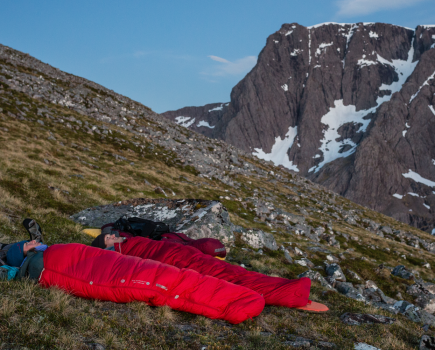Whether you will be mountaineering or winter walking there are added hazards that are thrown at us by the cold, writes Ryan Simpson of Horizon Expeditions
It’s that time of year when (hopefully!) we will all be out enjoying the winter. Whether you will be mountaineering or winter walking there are added hazards that are thrown at us by the cold, writes Ryan Simpson of Horizon Expeditions. Exposure to the cold can produce various injuries that occur as a result of our inability to adapt to the low temperatures. These can be divided into localised injury to a body part (peripheral cold injury), generalised cooling of the entire body (systematic hypothermia), or both.
Extremities And Face
Frostnip: Actually the first stage of frostbite. Often occurs in skiers exposed to fast-moving, cold air. The skin will become itchy and sore, then will develop white, red and yellow patches and go numb. Simple rewarming by pressure of a warm hand is usually sufficient. People can suffer from a long-term insensitivity to hot and cold in that area after suffering from frostnip.
Frostbite: VERY SERIOUS! The tissues of the affected area freeze. Ice crystals form within the cells, causing them to rupture and die.
2nd stage: Skin freezes and hardens, but deep tissue remains soft and normal. The area will usually blister one to two days after being frozen. Skin may become permanently insensitive to hot and cold.
3rd Stage: Deep frostbite. Muscles, tendons, blood vessels and nerves all freeze. Skin will be hard and waxy and the use of that area will be lost. Usually results in purplish blisters that will turn black. These are usually blood-filled. Can result in amputation or, if left untreated, can fall off!
If you develop either of the latter two stages of frostbite, it is very important that you do not try to rapidly rewarm the area. Do not touch any hot or cold object. Keep the area warm by putting on gloves, socks or wrapping it and seek medical help immediately.
Feet
In winter we often just wear the warmest pair of boots that we can find. However, a risk from this is ‘immersion foot’. Immersion foot occurs when the feet are cold for a prolonged period of time, such as when wet with sweat and sealed in a very warm, not very breathable, boot. The symptoms begin with a tingling pain and itching, which will progress to cramps and complete numbness. The skin is initially red, but will become pale and then grey/blue. The soles of the feet will be wrinkled and tender. The best treatment is to carefully wash your feet and air dry them. Elevation and rest is the key here, so don’t go out and subject them to it again the next day (even if they feel ok); recovery takes time.
Head
You lose most of your body heat through your head and neck. Wear a hat when it is cold, and a buff or fleece with a high collar to protect your neck.
Heart/Core
Hypothermia occurs when the core body temperature drops below that which is necessary for normal body function (about 35°C).
The three stages:
Mild: Feel cold. Intermittent shivering. Breathing quick and shallow.
Moderate: Constant shivering. Poor co-ordination. Slurred speech. Feel exhausted. Lips, nose, fingers, extremities may turn blue. May appear ‘drunk’.
Severe: Confusion. Amnesia. Irrational/ aggressive behaviour. Shivering stops. Unconsciousness. Death.
Treayment:
Mild:
• Insulate from ground.
• Change wet clothing for warm, windproof, waterproof gear.
• Increase exercise, if possible.
• Get into a pre-warmed sleeping bag or blankets.
• Drink hot drinks, followed by candy or
other high-sugar foods.
• Apply heat to neck, armpits and groin.
Moderate:
• Apply warm bottles of water to the armpits and groin area (comfortably warm when touched by a hand and held in place).
• Fully conscious victims can sip lukewarm sweetened, non-alcoholic fluids. If their condition is clearly improving then more fluids and warmth can be administered.
• Medical attention should be sought out, even if a full recovery is achieved.
Severe:
• You should not administer fluids.
• Maintaining temperature and preventing further loss is the most important thing.
• If a person becomes unconscious from hypothermia monitor their breathing and pulse carefully.
• GET HELP ASAP!
Cold Injuries Prevention:
1. PREPARE
Read the weather forecast before you go out, especially the Mountain Weather Information Service (mwis.org.uk) and the Met Office’s (http://www.metoffice. gov.uk/loutdoor/mountainsafety). Get as much information about conditions in the area from locals, blogs and webcams.
2. CLOTHING
Ensure that you have enough clothing to keep you warm throughout the day. If you are wearing most of it in the car park, you need to pack more into your bag! It goes without saying that conditions are often very different on the tops than in the valleys. When packing clothing and equipment, don’t just think warmth, think coverage as well. A balaclava and a pair of goggles can cover your whole face and protect it from the elements. Wear gloves that also cover your wrists. Winter often requires tougher equipment than summer hillwalking, so consider investing in a ‘burly’ set of waterproofs. Always carry at least two pairs of spare gloves.
3. LAYERS
Wearing layers is the key to getting your body temperature comfortable. Wear a number of thinner layers rather than just one big fleece. That way you can adjust the layers so you are ‘just right’.
4. FEET
Don’t forget your feet. Many people make the mistake of simply buying the warmest pair of boots they can, but this needs more thought. Warmth IS important, but so is breathability. You do not want your feet to be wet with sweat all day (immersion foot is miserable!). When winter climbing, carry a spare dry pair of socks to put on after the hot, sweaty walk in. That way your feet stay comfortable all day.







